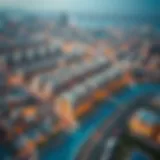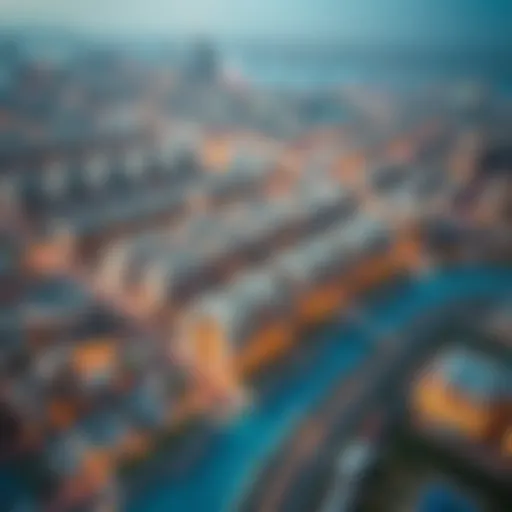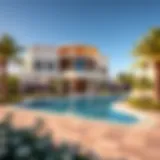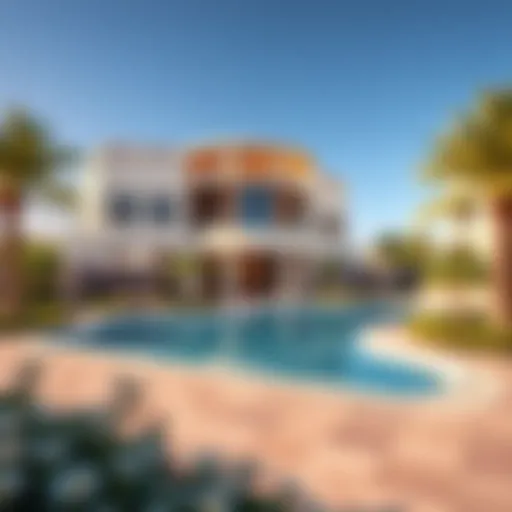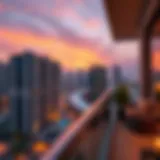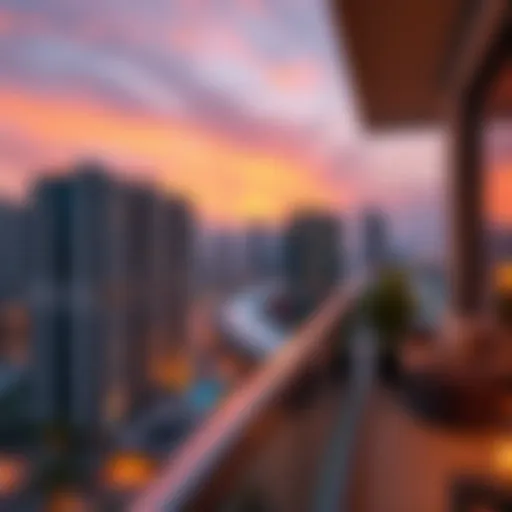Discovering the Importance of Ras Al Khor in Dubai


Intro
Ras Al Khor stands out as a hidden gem in the sprawling city of Dubai. Nestled between the vastness of urban development and expansive natural wetlands, this unique area embodies an intriguing blend of ecological richness and urban sophistication. As we embark on a journey through the Ras Al Khor map, let’s uncover its geographical layout, delve into its ecological significance, and grasp the essential landmarks that contribute to its character. Understanding this area is not just about transactions in real estate; it’s about appreciating a vibrant ecosystem that supports both wildlife and the urban populace.
Area Overview
Neighborhood Characteristics
Ras Al Khor’s distinctive character is molded by its unique geography and diverse environments. From the numerous wildlife reserves to the bustle of city life, every inch of this area serves a purpose. The Ras Al Khor Wildlife Sanctuary, for instance, is home to varied bird species like flamingos and herons, making it a sought-after spot for nature lovers and bird watchers alike. In addition to its ecological importance, the area remains a vital cornerstone for Dubai's urban landscape, enmeshed with impressive architectural developments.
Besides its natural allure, Ras Al Khor boasts several residential neighborhoods that cater to a range of lifestyles. These neighborhoods present a mix of high-end apartments, cozy villas, and essential amenities, making them appealing for families and expatriates wanting access to both city life and an eco-friendly setting.
This integration of commercial zones with natural habitats creates a living mosaic where residents experience a touch of nature while enjoying urban comforts. The flow between residential areas and commercial districts is seamless, enabling ease of movement across the map and enriching daily life for locals.
Cost of Living Analysis
Living in Ras Al Khor can vary significantly depending on your lifestyle choices. The residential properties in the area offer a wide price range.
- Affordable Housing: Numerous apartment complexes provide decent living spaces without breaking the bank.
- Luxury Options: For those seeking upscale living, there are villas and high-rise apartments that showcase premium facilities.
On the whole, Ras Al Khor is often more budget-friendly compared to other popular districts in Dubai, making it an attractive choice for newcomers. Although utility and grocery prices can be somewhat similar across the city, the option to find reasonably priced housing here can ease financial pressure.
"Ras Al Khor remains a desirable spot due to its blend of affordability and ecological richness, setting a benchmark for sustainable urban living."
Lifestyle Insights
Cultural and Recreational Activities
The cultural scene in Ras Al Khor is equally captivating. The area garners attention not just for nature, but also for community and recreational activities that foster connections among residents. Local events often draw in families seeking entertainment and engagement in community life. Outdoor activities, such as hiking and biking in designated trails or simply enjoying a day out at the sanctuary can invigorate one’s spirit.
Moreover, an experience is never complete without delving into local traditions. Participating in cultural festivals can provide meaningful insight into the Arab heritage that envelops this dynamic area.
Local Dining Experiences
When hunger strikes, Ras Al Khor serves up a bevy of dining options. From international cuisine to local delicacies, there’s something for every palate. Family-friendly cafes dot the landscape, while upscale restaurants offer a taste of luxury dining. Notable dining spots include:
- Shabestan: Renowned for its Persian cuisine, it's a must-visit for fans of traditional flavors.
- The Dubai Restaurant: Offers classic Middle Eastern plates with a slight twist that quickly becomes a go-to for locals.
In essence, this area cultivates a vibrant lifestyle interspersed with cultural richness and mouth-watering culinary experiences, making it an ideal place for expatriates and residents alike.
Prologue to Ras Al Khor
Ras Al Khor is more than just a location within the bustling city of Dubai; it is a microcosm of ecological diversity and urban development that presents a unique juxtaposition of nature and progress. Located on the fringes of the city's urban sprawl, this area lures both residents and visitors alike with its rich tapestry of flora and fauna, as well as its rapidly evolving infrastructure. Understanding Ras Al Khor is essential for anyone interested in the nuanced coexistence of wildlife and urban life, especially against the backdrop of one of the most dynamic cities in the world.
The significance of this region extends beyond mere geography. It serves as a critical habitat for various bird species, particularly flamingos, enhancing the region's ecological importance. Additionally, as urban development continues to unfold, Ras Al Khor stands at the crossroads of conservation and progress, illustrating the delicate balance that must be maintained in rapidly developing urban environments. The need to appreciate this area is not just about enjoying its scenic views or spotting wildlife; it’s also about recognizing the role that its map and layout play in guiding us through both its natural and man-made attractions.
Familiarizing oneself with Ras Al Khor’s geographical and historical context enriches our understanding and appreciation of this locale, enhancing the experience of exploring the area.
Geographical Overview
Ras Al Khor is strategically located at the southeastern edge of Dubai, where the Arabian Gulf meets a series of wetlands and mudflats. This geographical setup leads to stunning vistas, where the horizon is punctuated by both modern skyscrapers and sprawling natural landscapes. The wetlands are crucial not only for biodiversity but also for their role in flood control and water purification. This duality of purpose makes Ras Al Khor a focal point in discussions about sustainable urban planning.
The area is characterized by its unique ecological zones, which include mangroves, mudflats, and sandy beaches. This diversity creates a variety of habitats that support a rich array of wildlife. The Ras Al Khor Wildlife Sanctuary, which occupies a significant portion of the area, is a testament to the rich biodiversity inherent to this locale.
To navigate and understand this region fully, it is essential to delve into its map. The layout showcases key features such as roads, water bodies, and areas designated for conservation, together painting a detailed portrait of how humans interact with the environment here.
Historical Context
The history of Ras Al Khor is deeply intertwined with the development of Dubai itself. Initially, it served as a vital area for fishing and pearl diving, which were essential to the local economy. As Dubai transformed from a modest trading post into a global metropolis, the landscape of Ras Al Khor underwent its own metamorphosis.
Over the decades, Ras Al Khor evolved in response to economic booms and changes in environmental policy. The establishment of the Ras Al Khor Wildlife Sanctuary in 1985 marked a turning point, as it illustrated a growing awareness of the importance of preserving natural habitats amidst urban growth. This sanctuary not only protects local wildlife but also reflects the commitment of Dubai to balance development with sustainability.
The historical trajectory of Ras Al Khor showcases how human activity can both positively and negatively impact the environment. As urbanization continues full throttle, reflecting on the past offers critical lessons for sustainable development in the future.
"Ras Al Khor is not just a place; it embodies the very principles of coexistence between urban life and environmental stewardship."


Understanding the Ras Al Khor Map
Understanding the Ras Al Khor map goes beyond just being a tool for navigation; it's a doorway to appreciate the intricate weave of urban development, ecological conservation, and cultural significance in this unique Dubai locale. A well-crafted map provides insights into the area’s layout while unraveling the stories embedded within its spaces. By closely examining the Ras Al Khor map, readers gain critical perspectives on their surroundings, be they residents, visitors, or agents in the property market.
Maps are not just about locations; they tell tales. They highlight the juxtaposition of bustling city life against serene natural habitats, the establishment of built environments alongside sustained conservation efforts. Having a solid grasp of this cartographic representation augments one's experience, whether in planning a family outing, mapping a wildlife adventure, or considering real estate investments.
Map Essentials
The essentials of the Ras Al Khor map encompass a variety of features, each crucial for understanding the space more fully. Landmarks, roadways, and green spaces are fundamental components of this unique urban ecosystem.
- Landmarks: From the Ras Al Khor Wildlife Sanctuary, renowned for its flamingos, to the impressive Dubai Aquarium and Underwater Zoo, these spots are not just visually captivating but serve as markers of ecological and economic significance.
- Roadways: Well-planned roads and passages help ensure that travel within Ras Al Khor is seamless. Roads such as the Sheikh Mohammed Bin Zayed Road and Al Amardi Street facilitate smooth transitions between urban and natural spaces.
- Green Spaces: The map also illuminates the designated areas for natural habitats and reserves. Understanding their boundaries is pivotal in promoting both recreational activities and environmental consciousness.
By grasping these essentials, one can navigate through Ras Al Khor with greater purpose. Each route taken could lead to a remarkable discovery, whether that be spotting a rare bird or viewing a breathtaking sunset over the lagoon.
Navigational Features
Navigational features of the Ras Al Khor map serve as the guiding force for both seasoned explorers and first-time visitors. Through geographical context and navigational aids, the map ensures that no visitor is lost in this intriguing oasis amid the urban sprawl.
- Direction Indicators: Most maps include orientation markers like a north arrow. Familiarizing oneself with these indicators opens up a landscape that otherwise feels foreign.
- Symbols and Legends: A plethora of symbols detail parks, public facilities, and transportation hubs. Knowing what each symbol signifies not only helps in traversing the area but also enriches the overall experience.
- Digital Avenues: Many modern maps are enhanced with digital features, including GPS capabilities that make finding routes much simpler. Utilizing tools available on platforms such as Google Maps can divert anyone from potential confusion, presenting real-time traffic conditions and automated route suggestions.
“A good map is like a friend; it shows you different paths without judgment.”
To dive deeper into Ras Al Khor, reliable resources such as Wikipedia can provide further context on key attractions and ecological details. Additionally, local community pages on Facebook can be a treasure trove for personal stories and experiences shared by those who call Ras Al Khor home.
Ecological Significance
Ras Al Khor, a critical part of Dubai's ecological landscape, serves as more than just a picturesque locale for visitors. Its diverse ecosystems play a vital role in supporting local wildlife and maintaining environmental balance. This section dives into the significance of Ras Al Khor's ecological dimensions, showcasing both the inherent value of its wildlife habitats and the impactful conservation efforts underway.
Wildlife Habitats
The wildlife habitats within Ras Al Khor are a treasure trove of biodiversity. From wading birds to marine life, this area is a sanctuary that offers refuge to many species. The Ras Al Khor Wildlife Sanctuary in particular holds the spotlight, embodying a mosaic of habitats including mudflats, mangroves, and lagoons.
- An impressive over 450 species of wildlife find their home here, particularly during migratory seasons.
- The sanctuary is recognized as a Ramsar Wetland of International Importance, highlighting its global ecological value.
- Flamingoes, often seen wading in the shallows, signify the sanctuary’s health and biodiversity. They thrive on the diverse plant life found in the lagoons, feeding on the nutrients that flourish in these rich waters.
In terms of habitat complexity, Ras Al Khor’s environment is imperative:
- Mangroves cover part of the shoreline, providing breeding grounds for fish and acting as natural barriers against coastal erosion.
- Mudflats act as feeding areas for migratory birds, teeming with invertebrates and organic matter.
- These varied ecosystems ensure a balanced environment, aiding in the regulation of water quality and providing essential nutrients.
Environmental Conservation Efforts
An essential aspect of maintaining the ecological significance of Ras Al Khor is the commitment shown through environmental conservation efforts. Initiatives focused on protection and rehabilitation reflect a collective responsibility to safeguard this unique environment.
"Conservation is a state of harmony between men and land." - Aldo Leopold
- Authorities have established strict regulations to limit pollution and human interference, ensuring wildlife can thrive.
- Educational programs targeting locals and tourists promote awareness and stewardship, reminding visitors of their role in preserving this delicate ecosystem.
- Partnerships with environmental organizations work towards research and monitoring, keeping track of the health of both fauna and flora.
- Ongoing restoration projects are aimed at revitalizing damaged habitats to restore their original function and beauty.
Monitoring and research also play key roles in these efforts. For instance:
- Researchers frequently assess bird populations and their migratory patterns, providing insight into ecological changes.
- Studies focus on how climate change influences habitat dynamics, enabling adaptive management practices.
In summary, the ecological significance of Ras Al Khor is multifaceted, encompassing both the richness of its wildlife habitats and the vigorous conservation initiatives that seek to protect them. This delicate balance is crucial, not only for the local ecosystem but for ensuring that future generations can also appreciate this vital area of Dubai.
For further insights, you can explore the habitats and conservation efforts more closely at Ras Al Khor Wildlife Sanctuary. Recommended readings on ecological issues can also be found at Britannica and Wikipedia. As you navigate this unique area, remember the impact of your presence within this special ecological sanctuary.
Key Landmarks in Ras Al Khor
Ras Al Khor is not just a geographical location in Dubai; it carries significant cultural, historical, and environmental weight. The key landmarks in this area showcase the various elements that make Ras Al Khor unique. They highlight not just the beauty of the Emirates but also illustrate how urban development and nature can coexist in harmony. Each landmark has its own story, a piece of the mosaic that makes up this vibrant locale.
Ras Al Khor Wildlife Sanctuary
Ras Al Khor Wildlife Sanctuary stands out as the crown jewel in this area. Covering over 6.2 square kilometers, it's a haven for many migratory birds and serves as a critical habitat for local wildlife. The sanctuary's extensive mudflats, mangroves, and lagoons create a perfect ensemble for over 450 species of birds, including the elegant flamingo. Every winter, thousands of flamingos flock here, their striking pink feathers contrasting beautifully against the lush greens and blues of the sanctuary.
Visiting this sanctuary isn't just for birdwatchers; it plays a pivotal role in environmental education. Various programs engage the community in conservation efforts while promoting awareness about climate change and biodiversity.
"The sanctuary is a reminder of the delicate balance we must maintain between development and nature."


Dubai Aquarium and Underwater Zoo
Another noteworthy landmark is the Dubai Aquarium and Underwater Zoo, located within the Dubai Mall, not far from Ras Al Khor. While it may not sit directly in the heart of Ras Al Khor, its connection to the area's aquatic ecology and marine education cannot be overstated. This colossal aquarium is home to thousands of aquatic animals, including several species native to the Arabian Gulf.
It's more than just an attraction; the aquarium fosters a deeper understanding of marine ecosystems, encouraging visitors to appreciate and protect these environments. The underwater tunnel provides an immersive experience, making one feel like they are walking through the ocean, surrounded by sharks and rays. Moreover, it offers various interactive experiences, like behind-the-scenes tours and feeding sessions, which connect visitors directly to aquatic life.
Residential Developments
Lastly, the residential developments around Ras Al Khor reflect the dynamic lifestyle of Dubai. Modern residential complexes, like the Dubai Creek Harbour, blend effortlessly with the natural surroundings. This area is rapidly evolving, with a vision that emphasizes sustainability while promoting a high quality of life for its residents.
These developments often showcase stunning views of the Wildlife Sanctuary and the Creek itself, reminding inhabitants of the natural landscapes that exist within the urban environment. Furthermore, the blend of modern amenities with green spaces emphasizes a solid commitment to eco-friendly living. It's not just about homes; it's a conscious effort to create a healthier lifestyle embedded within the rich ecological tapestry of Ras Al Khor.
Overall, each landmark in Ras Al Khor contributes to the area’s unique identity, merging the richness of nature with human ingenuity. From wildlife to modern living spaces, the landmarks play a vital role in showcasing the importance of sustainable development, ecological awareness, and cultural heritage.
Urban Development in Ras Al Khor
Urban development in Ras Al Khor is not just about brick and mortar; it’s about shaping a community that harmonizes with nature, enhances living standards, and meets the needs of its diverse population. The strategic location offers significant advantages for economic activities, residential life, and environmental conservation, making it a focal point of interest for expatriates, tourists, and locals alike.
The relaxed regulations regarding construction and development, combined with the beauty of the natural surroundings, provides developers a unique canvas. This results in a blend of modern architecture and ecological conservation, allowing for urban growth that respects existing ecosystems, particularly the vital wildlife sanctuary noted for its flamingos and other migratory birds.
Benefits of Focused Development
- Economic Prosperity: The urban expansion has attracted numerous businesses that contribute to the local economy.
- Enhanced Infrastructure: Improved roads and public transport options enhance accessibility and connectivity, making it easier for residents and visitors to navigate.
- Sustainable Practices: Emphasis on green building practices ensures that developments have minimal impact on the local environment while supporting tourism and habitation.
Considerations in Urban Planning
When planning urban development in Ras Al Khor, several elements must be taken into account:
- Ecological Preservation: Continuous assessment of environmental impacts is essential. Protecting local flora and fauna must be prioritized.
- Community Needs: Urban development should reflect the demographic diversity of the area, ensuring adequate amenities for families, expats, and tourists.
- Cultural Sensitivity: Keeping in line with Dubai's vibrant cultural landscape requires considering local customs and traditional architecture in new designs.
"Sustainable urban development must go hand in hand with cultural preservation, creating spaces where people feel at home yet connected to the broader ecosystem."
Current Projects
Several projects are underway in Ras Al Khor that are shaping the future of the area. Each aims to add diverse functionality while enhancing the quality of life.
- Ras Al Khor Business Park: Aiming to become a leading business hub, this project is designed to promote economic activities while allowing easy access to nearby transport links.
- Residential Complexes: Modern apartments and villas are being developed with green spaces to accommodate the growing population. These projects emphasize community living and environmental responsibility.
- Mixed-Use Developments: These projects combine residential, commercial, and recreational spaces, offering convenience and fostering community interaction.
The current projects are setting the stage for a vibrant future in Ras Al Khor. They promise to not only accommodate residents but also enhance the appeal to visitors and businesses alike.
Future Prospects
Looking ahead, the future of urban development in Ras Al Khor lays a strong foundation for sustainable and inclusive growth. With Dubai continuing its rapid transformation, several key elements will influence what happens next.
- Technological Integration: Smart city initiatives could pave the way for improved living conditions, with advanced technologies integrated into daily urban life.
- Rail and Metro Expansion: Upcoming public transport projects will greatly improve access to the area, facilitating movement for residents and tourists.
- Civic Spaces: Plans for parks, community centers, and cultural hubs are being discussed to promote a sense of community and belonging among residents.
As urban facilities expand alongside environmental consciousness, Ras Al Khor is positioned to become a model for urban development that others might look to replicate. It represents a harmonious blend of growth, sustainability, and thriving community life, making it a noteworthy aspect of Dubai's landscape.
Transportation and Accessibility
Transportation and accessibility play a pivotal role in understanding Ras Al Khor's significance within Dubai. The ease with which one can navigate this area directly influences its attraction to expatriates, tourists, and locals alike. With its unique blend of urban developments and natural habitats, Ras Al Khor is not only an ecological treasure but also a key connecting point in Dubai's vast metropolitan landscape. This section will explore the essential elements that contribute to smooth transportation and accessibility in the region, emphasizing the multifaceted benefits that arise from an effective connectivity framework.
Road Connectivities
Road connectivity is crucial in facilitating effective transport across Ras Al Khor and linking it with neighboring districts. Major arterial roads like Sheikh Mohammed Bin Zayed Road and Al Ain Road provide direct access to Ras Al Khor, allowing commuters to transition from urban centers to this ecological enclave with minimal hassle.
- Enhancing Commuter Experience: Smooth and well-maintained roads streamline the daily commute for residents and businesses, significantly reducing travel times. The integration of signage and navigational aids on these roads further aids in minimizing misdirection, ensuring that travelers find their way to the area without unnecessary detours.
- Accessibility for Goods Transport: The roadways play a vital role for commercial activities, enabling businesses to easily transport goods in and out of Ras Al Khor. This accessibility fosters economic growth within the region, as companies can efficiently distribute products and services.
- Future Developments: Ongoing infrastructure projects aim to improve and expand road networks within Ras Al Khor, ensuring that it remains competitive as a desirable residential and commercial locale. As urban demands change, the emphasis on efficient road connections will only set to grow.
“Transport infrastructure is the backbone of urban development, shaping not just the landscape but the economy and social fabric of a region.”
While roadways are essential, it is equally important to acknowledge pedestrian connectivity, which is often overlooked but adds significant value to the area. Walking paths and bicycle lanes will promote a healthier lifestyle and reduce the carbon footprint, resonating with the overall ecological ethos of Ras Al Khor.
Public Transport Options
Public transport serves as another crucial artery for accessibility in Ras Al Khor, relieving congestion on the roads while providing a budget-friendly travel solution for both residents and tourists. Various transit options integrate seamlessly into the urban fabric, ensuring that all parts of Ras Al Khor are easily reachable.
- Dubai Metro: The Dubai Metro’s proximity to Ras Al Khor connects commuters directly to the broader public transport network. A proposed station in this area would significantly enhance access to and from Ras Al Khor, allowing for easier commuter flow.
- Buses: The RTA operates several bus lines that link Ras Al Khor with other important districts across Dubai. These buses are often well-timed to coincide with peak commuting hours, providing a reliable means of transport for daily travelers.
- Future Integration: Plans for further developing public transport are on the horizon, with discussions around expanding routes and introducing innovative transport solutions like water taxis. Such developments aim to complement the existing network, giving options that cater to various preferences and schedules.


For more detailed information surrounding public transport in Dubai, check out the RTA website.
Cultural Impact
The cultural landscape of Ras Al Khor is a blend of tradition and modernity, reflecting the vibrant tapestry of Dubai. This area illustrates not just the ethnic diversity of its inhabitants but also the tapestry of customs and traditions that come together to form a unique identity. Understanding the cultural impact of Ras Al Khor provides valuable insights for many, including expatriates, tourists, and real estate agents, all of whom are navigating this lively locale.
One significant aspect of Ras Al Khor's cultural impact is its role in fostering community engagement. The environment here inspires collaboration among residents, encouraging local initiatives aimed at promoting awareness of the area's ecological treasures. Events are often held that invite citizens to participate in environmental clean-ups and educational workshops. Engaging in these activities strengthens community bonds and instills a sense of ownership and pride in the locality. By aligning people's interests with the environment, residents help cultivate a culture of sustainability that resonates beyond neighborhood boundaries.
Additionally, the cultural fabric of this region is stitched together by the interaction of various groups, each contributing to the residency experience. This exchange is particularly visible in the blend of artistic expression and heritage preservation. Cultural festivals highlighting traditional Emirati arts and crafts offer glimpses into the past while weaving in contemporary influences. Through storytelling, local dance, and culinary arts, Ras Al Khor becomes a vibrant epicenter where history and modern life coexist harmoniously.
"Cultural initiatives not only enrich the community but also position Ras Al Khor as a destination for cultural tourism, creating a vibrant economic cycle that reverberates throughout Dubai."
In summary, the cultural impact of Ras Al Khor goes beyond mere aesthetics; it shapes lives, strengthens communities, and builds a shared identity. A closer analysis of community engagement and artistic endeavors reveals this intersection of cultural threads, serving as an integral element in Dubai's rich narrative.
Community Engagement Initiatives
When discussing community engagement initiatives in Ras Al Khor, it becomes clear these programs are more than simple activities; they represent a concerted effort to enhance the social fabric and promote collaboration among residents. The Ras Al Khor community, characterized by its diversity, has seen significant initiatives aimed at engaging various demographics, from expatriates to natives.
Local people participate in hands-on projects that range from wildlife conservation efforts in the Ras Al Khor Wildlife Sanctuary to cultural workshops that involve traditional crafts. These initiatives create opportunities for dialogue between different cultures, fostering understanding and solidarity. Events like the annual Ras Al Khor Community Festival showcase talents across the board, encouraging participation from artists, musicians, and food vendors, which not only enriches local culture but spurs economic activity.
Moreover, schools and NGOs play a vital role in these initiatives. Educational programs often include field trips to explore local ecosystems and understand their significance. This experiential learning lets younger generations appreciate their heritage and instill values of environmental stewardship, thereby fostering a proactive spirit for future custodians of the area.
Art and Heritage in Ras Al Khor
Art and heritage in Ras Al Khor are a reflection of the intermingling of various cultural influences over the years. This locality has an inherent artistic flair, and it thrives on celebrating its diverse heritage through various mediums. From visual arts to music and public installations, Ras Al Khor has become a canvas that tells a story.
Local art showcases often highlight traditional Emirati styles, featuring calligraphy, pottery, and textiles, thus preserving a rich cultural history. Moreover, artists from different backgrounds contribute to this cultural mosaic, introducing contemporary elements that resonate with the younger crowd. The outdoor galleries and pop-up exhibitions often display not only artwork but also narratives that encapsulate the essence of community life here.
The heritage aspect is further amplified by local museums and cultural centers, which offer a deep dive into the region's past. Institutions such as the Dubai Museum serve as custodians of the history that shapes local identities. By connecting past and present, they facilitate a better understanding of how Ras Al Khor has evolved over time.
In essence, art and heritage in Ras Al Khor are pivotal to the region's identity and cultural dynamism. They enhance community interactions, provide a platform for creative expression, and celebrate the unique story of this area within Dubai's vast metropolitan landscape.
Tips for Exploring Ras Al Khor
When diving into the intricate tapestry of Ras Al Khor, being armed with the right tips can make all the difference. This part of Dubai isn't just a side note on a map; it’s an experience waiting to unfold, blending nature's bounty with urban development. Understanding how to navigate this area—timing your visit, selecting activities—will enhance your exploration immensely.
Best Times to Visit
The climate in Ras Al Khor is nothing short of characteristic of a desert city. Summers can be scorching, with temperatures often exceeding 40°C. The wise individual may consider planning a visit during the cooler months, specifically from November to March. During this period, the temperatures hover around a pleasant 20-30°C, ideal for both outdoor activities and wildlife spotting.
- Morning Hours: Early risers will find a peaceful ambiance, especially in the Wildlife Sanctuary. Birds are most active at dawn, and many species can be observed without straying far from the trails.
- Winter Months: These months also coincide with migratory patterns of many bird species, including flamingos, making it a birdwatcher's paradise.
- Avoiding Holidays: A midweek visit can help dodge the crowds, particularly during local holidays or festivals, ensuring a more tranquil experience.
Recommended Activities
Ras Al Khor is a treasure trove of engaging activities that cater to all kinds of explorers. Here are some noteworthy suggestions:
- Wildlife Sanctuary Visits: This is not just a sanctuary, but a refuge for over 450 species of wildlife. Grab binoculars and spend some time in the observation hides that overlook the water bodies.
- Kayaking Adventures: For those who fancy a bit of paddling, the waters around Ras Al Khor are ripe for kayaking. Rentals are available, allowing you to glide quietly and maybe spot a few dolphins or native birds.
- Cultural Tours: Engage in guided tours that delve into the locality’s history, enriching your understanding beyond just what meets the eye.
- Photography Safaris: Whether you are a professional or an amateur, the golden hour provides stunning backdrops for capturing the true essence of this locale.
"Exploring Ras Al Khor is like peeling back layers of an onion; each layer reveals the beauty and complexity of nature fused with urban life."
- Community Events: Keep an eye out for local festivals or events, often held at nearby community centers. These events can be a great way to engage with locals and learn more about the culture.
Being mindful of when to visit and what activities to engage in not only adds layers to the enjoyment but also illuminates the unique facets of Ras Al Khor that might otherwise go unnoticed.
Finale
Reflecting on the significance of Ras Al Khor, it's clear that this unique locale in Dubai embodies much more than just a geographical area. It cradles an ecosystem that is both rich and fragile, showcasing the delicate balance between urban development and nature preservation. Understanding the Ras Al Khor map and its various features leads to numerous insights about its ecological and cultural importance.
Recapping Key Insights
In exploring the fascinating details of Ras Al Khor, several key insights emerge:
- Geographical Diversity: The area stands out due to its wetlands, mangroves, and rich biodiversity, making it a haven for various wildlife species, especially migratory birds.
- Cultural Fabric: It's not just about nature; the cultural initiatives and community engagement activities play a vital role in situating Ras Al Khor within the broader scope of Dubai's heritage.
- Urban Development: Through examining current projects and future prospects, one sees the blend of modern architecture with the natural landscape, emphasizing sustainability.
These insights encapsulate the essence of Ras Al Khor, highlighting its dual role as a critical ecological reserve and a dynamic urban space.
The Future of Ras Al Khor
Looking ahead, Ras Al Khor is poised for exciting transformations. As development continues, projects will aim to enhance connectivity while putting a spotlight on environmental conservation. This balanced approach will help retain the ecological character that makes Ras Al Khor special.
Furthermore, the ongoing community initiatives promise to weave local traditions into future urban designs, ensuring that as the area grows, it remains deeply rooted in its cultural identity. For tourists and locals alike, the importance of Ras Al Khor in the metropolitan landscape of Dubai cannot be overstated.
In summary, as we reflect on the layers of complexity presented by Ras Al Khor, it’s essential for visitors, residents, and policymakers to recognize and champion the significance of this vibrant locale. Whether it's appreciating the rich wildlife or acknowledging the thoughtful urban planning, the future of Ras Al Khor represents a collaborative effort that benefits all.




